Naproxen-Based Hydrazones as Effective Corrosion Inhibitors for Mild Steel in 1.0 M HCl
Abstract
1. Introduction
2. Materials and Methods
2.1. Materials and Electrolytes
2.2. Weight Loss (WL)
2.3. Electrochemical Measurements
2.4. Scanning Electron Microscopy (SEM)/Energy Dispersive Spectroscopy (EDX) Studies
3. Results and Discussion
3.1. Weight Loss Measurements
3.1.1. Concentration Effect
3.1.2. Temperature Effect
3.2. Potentiodynamic Polarization (PDP) Study
3.3. Electrochemical Impedance Spectroscopy (EIS)Study
3.3.1. Concentration Effect
3.3.2. Immersion Time Effect
3.4. Adsorption Isotherm
3.5. Scanning Electron Microscopy (SEM)/Energy Dispersive Spectroscopy (EDX) Study
4. Conclusions
Supplementary Materials
Author Contributions
Funding
Acknowledgments
Conflicts of Interest
References
- Eddy, N.O.; Ita, B.I. QSAR, DFT and quantum chemical studies on the inhibition potentials of some carbozones for the corrosion of mild steel in HCl. J. Mol. Model. 2011, 17, 359–376. [Google Scholar] [CrossRef] [PubMed]
- Agrawal, A.; Sahu, K. An overview of the recovery of acid from spent acidic solutions from steel and electroplating industries. J. Hazard. Mater. 2009, 171, 61–75. [Google Scholar] [CrossRef] [PubMed]
- Lgaz, H.; Salghi, R.; Ali, I.H. Corrosion inhibition behavior of 9-Hydroxyrisperidone as a green corrosion inhibitor for mild steel in hydrochloric acid: Electrochemical, DFT and MD simulations studies. Int. J. Electrochem. Sci. 2018, 13, 250–264. [Google Scholar] [CrossRef]
- El-Hajjaji, F.; Belghiti, M.E.; Hammouti, B.; Jodeh, S.; Hamed, O.; Lgaz, H.; Salghi, R. Adsorption and corrosion inhibition effect of 2-mercaptobenzimidazole (surfactant) on a carbon steel surface in an acidic medium: Experimental and monte carlo simulations. Port. Electrochim. Acta 2018, 36, 197–212. [Google Scholar] [CrossRef]
- Singh, A.; Ansari, K.R.; Quraishi, M.A.; Lgaz, H. Effect of electron donating functional groups on corrosion inhibition of J55 steel in a sweet corrosive environment: Experimental, density functional theory, and molecular dynamic simulation. Materials 2019, 12, 17. [Google Scholar] [CrossRef] [PubMed]
- Petrunin, M.; Maksaeva, L.; Gladkikh, N.; Makarychev, Y.; Maleeva, M.; Yurasova, T.; Nazarov, A. Thin benzotriazole films for inhibition of carbon steel corrosion in neutral electrolytes. Coatings 2020, 10, 362. [Google Scholar] [CrossRef]
- Odewunmi, N.A.; JafarMazumder, M.A.; Ali, S.A.; Aljeaban, N.A.; Alharbi, B.G.; Al-Saadi, A.A.; Obot, I.B. Impact of degree of hydrophilicity of pyridinium bromide derivatives on HCl pickling of X-60 mild steel: Experimental and theoretical evaluations. Coatings 2020, 10, 185. [Google Scholar] [CrossRef]
- Jawad, Q.A.; Zinad, D.S.; Dawood Salim, R.; Al-Amiery, A.A.; Sumer Gaaz, T.; Takriff, M.S.; Kadhum, A.A.H. Synthesis, characterization, and corrosion inhibition potential of novel thiosemicarbazone on mild steel in sulfuric acid environment. Coatings 2019, 9, 729. [Google Scholar] [CrossRef]
- Hu, J.; Wang, T.; Wang, Z.; Wei, L.; Zhu, J.; Zheng, M.; Chen, Z. Corrosion protection of N80 steel in hydrochloric acid medium using mixed C15H15NO and Na2WO4 inhibitors. Coatings 2018, 8, 315. [Google Scholar] [CrossRef]
- Eduok, U.; Ohaeri, E.; Szpunar, J. Electrochemical and surface analyses of X70 steel corrosion in simulated acid pickling medium: Effect of poly (N-vinyl imidazole) grafted carboxymethyl chitosan additive. Electrochim. Acta 2018, 278, 302–312. [Google Scholar] [CrossRef]
- Deyab, M. Corrosion inhibition of heat exchanger tubing material (titanium) in MSF desalination plants in acid cleaning solution using aromatic nitro compounds. Desalination 2018, 439, 73–79. [Google Scholar] [CrossRef]
- Bentiss, F.; Jama, C.; Mernari, B.; El Attari, H.; El Kadi, L.; Lebrini, M.; Traisnel, M.; Lagrenée, M. Corrosion control of mild steel using 3, 5-bis (4-methoxyphenyl)-4-amino-1, 2, 4-triazole in normal hydrochloric acid medium. Corros. Sci. 2009, 51, 1628–1635. [Google Scholar] [CrossRef]
- Glasgow, I.; Rostron, A.; Thomson, G. Hydrogen absorption by very strong steel during chemical descaling. Corros. Sci. 1966, 6, 469–482. [Google Scholar] [CrossRef]
- Soltani, N.; Behpour, M.; Oguzie, E.; Mahluji, M.; Ghasemzadeh, M. Pyrimidine-2-thione derivatives as corrosion inhibitors for mild steel in acidic environments. RSC Adv. 2015, 5, 11145–11162. [Google Scholar] [CrossRef]
- Singh, P.; Srivastava, V.; Quraishi, M. Novel quinoline derivatives as green corrosion inhibitors for mild steel in acidic medium: Electrochemical, SEM, AFM, and XPS studies. J. Mol. Liq. 2016, 216, 164–173. [Google Scholar] [CrossRef]
- Yüce, A.O.; Mert, B.D.; Kardaş, G.; Yazıcı, B. Electrochemical and quantum chemical studies of 2-amino-4-methyl-thiazole as corrosion inhibitor for mild steel in HCl solution. Corros. Sci. 2014, 83, 310–316. [Google Scholar] [CrossRef]
- Al-Sehemi, A.G.; Irfan, A.; Alfaifi, M.; Fouda, A.M.; El-Gogary, T.M.; Ibrahim, D.A. Computational study and in vitro evaluation of the anti-proliferative activity of novel naproxen derivatives. J. King Saud Univ. Sci. 2017, 29, 311–319. [Google Scholar] [CrossRef]
- Almasirad, A.; Tajik, M.; Bakhtiari, D.; Shafiee, A.; Abdollahi, M.; Zamani, M.J.; Khorasani, R.; Esmaily, H. Synthesis and analgesic activity of N-arylhydrazone derivatives of mefenamic acid. J. Pharm. Pharm. Sci. 2005, 8, 419–425. [Google Scholar]
- Rakha, T.; El-Gammal, O.; Metwally, H.; El-Reash, G.A. Synthesis, characterization, DFT and biological studies of (Z)-N′-(2-oxoindolin-3-ylidene) picolinohydrazide and its Co (II), Ni (II) and Cu (II) complexes. J. Mol. Struct. 2014, 1062, 96–109. [Google Scholar] [CrossRef]
- Rollas, S.; Küçükgüzel, S.G. Biological activities of hydrazone derivatives. Molecules 2007, 12, 1910–1939. [Google Scholar] [CrossRef]
- Albayati, M.R.; Kansız, S.; Dege, N.; Kaya, S.; Marzouki, R.; Lgaz, H.; Salghi, R.; Ali, I.H.; Alghamdi, M.M.; Chung, I.-M. Synthesis, crystal structure, Hirshfeld surface analysis and DFT calculations of 2-[(2, 3-dimethylphenyl) amino]-N′-[(E)-thiophen-2-ylmethylidene] benzohydrazide. J. Mol. Struct. 2020, 1205, 127654. [Google Scholar] [CrossRef]
- Mohamad, A.D.M.; Abualreish, M.; Abu-Dief, A.M. Antimicrobial and anticancer activities of cobalt (III)-hydrazone complexes: Solubilities and chemical potentials of transfer in different organic co-solvent-water mixtures. J. Mol. Liq. 2019, 290, 111162. [Google Scholar] [CrossRef]
- Lgaz, H.; Chaouiki, A.; Albayati, M.R.; Salghi, R.; El Aoufir, Y.; Ali, I.H.; Khan, M.I.; Mohamed, S.K.; Chung, I.-M. Synthesis and evaluation of some new hydrazones as corrosion inhibitors for mild steel in acidic media. Res. Chem. Intermed. 2019, 45, 2269–2286. [Google Scholar] [CrossRef]
- Lgaz, H.; Chung, I.-M.; Albayati, M.R.; Chaouiki, A.; Salghi, R.; Mohamed, S.K. Improved corrosion resistance of mild steel in acidic solution by hydrazone derivatives: An experimental and computational study. Arab. J. Chem. 2020, 13, 2934–2954. [Google Scholar] [CrossRef]
- Lgaz, H.; Zehra, S.; Albayati, M.R.; Toumiat, K.; El Aoufir, Y.; Chaouiki, A.; Salghi, R.; Ali, I.H.; Khan, M.I.; Chung, I.-M.; et al. Corrosion inhibition of mild steel in 1.0 M HCl by two hydrazone derivatives. Int. J. Electrochem. Sci. 2019, 14, 6667–6681. [Google Scholar] [CrossRef]
- ASTM, G 31–72. American Society for Testing and Materials Philadelphia, PA. 1990.—Recherche Google. Available online: https://www.google.com/search?q=ASTM%2C+G+31%E2%80%9372%2C+American+Society+for+Testing+and+Materials+Philadelphia%2C+PA%2C+1990.&oq=ASTM%2C+G+31%E2%80%9372%2C+American+Society+for+Testing+and+Materials+Philadelphia%2C+PA%2C+1990.&aqs=chrome..69i57j69i60.4733j0j7&sourceid=chrome&ie=UTF-8 (accessed on 20 March 2019).
- Haynes, G. Review of laboratory corrosion tests and standards. In Corrosion Testing and Evaluation: Silver Anniversary Volume; ASTM International: West Conshohocken, PA, USA, 1990. [Google Scholar]
- Salghi, R.; Jodeh, S.; Ebenso, E.E.; Lgaz, H.; Ben Hmamou, D.; Belkhaouda, M.; Ali, I.H.; Messali, M.; Hammouti, B.; Fattouch, S. Inhibition of C-steel corrosion by green tea extract in hydrochloric solution. Int. J. Electrochem. Sci. 2017, 12, 3283–3295. [Google Scholar] [CrossRef]
- Bouoidina, A.; El-Hajjaji, F.; Drissi, M.; Taleb, M.; Hammouti, B.; Chung, I.-M.; Jodeh, S.; Lgaz, H. Towards a deeper understanding of the anticorrosive properties of hydrazine derivatives in acid medium: Experimental, DFT and MD simulation assessment. Metall. Mater. Trans. A 2018, 49, 5180–5191. [Google Scholar] [CrossRef]
- Bashir, S.; Sharma, V.; Lgaz, H.; Chung, I.-M.; Singh, A.; Kumar, A. The inhibition action of analgin on the corrosion of mild steel in acidic medium: A combined theoretical and experimental approach. J. Mol. Liq. 2018, 263, 454–462. [Google Scholar] [CrossRef]
- Tezcan, F.; Yerlikaya, G.; Mahmood, A.; Kardaş, G. A novel thiophene Schiff base as an efficient corrosion inhibitor for mild steel in 1.0 M HCl: Electrochemical and quantum chemical studies. J. Mol. Liq. 2018, 269, 398–406. [Google Scholar] [CrossRef]
- Singh, A.K.; Ebenso, E.E.; Quraishi, M. Adsorption behaviour of cefapirin on mild steel in hydrochloric acid solution. Int. J. Electrochem. Sci. 2012, 7, 2320. [Google Scholar]
- Bentiss, F.; Gassama, F.; Barbry, D.; Gengembre, L.; Vezin, H.; Lagrenée, M.; Traisnel, M. Enhanced corrosion resistance of mild steel in molar hydrochloric acid solution by 1, 4-bis (2-pyridyl)-5H-pyridazino [4, 5-b] indole: Electrochemical, theoretical and XPS studies. Appl. Surf. Sci. 2006, 252, 2684–2691. [Google Scholar] [CrossRef]
- Chakravarthy, M.; Mohana, K.; Kumar, C.P. Corrosion inhibition effect and adsorption behaviour of nicotinamide derivatives on mild steel in hydrochloric acid solution. Int. J. Ind. Chem. 2014, 5, 19. [Google Scholar] [CrossRef]
- Shukla, S.K.; Quraishi, M. 4-Substituted anilinomethylpropionate: New and efficient corrosion inhibitors for mild steel in hydrochloric acid solution. Corros. Sci. 2009, 51, 1990–1997. [Google Scholar] [CrossRef]
- Chen, W.; Hong, S.; Xiang, B.; Luo, H.; Li, M.; Li, N. Corrosion inhibition of copper in hydrochloric acid by coverage with trithiocyanuric acid self-assembled monolayers. Corros. Eng. Sci. Technol. 2013, 48, 98–107. [Google Scholar] [CrossRef]
- Solmaz, R. Investigation of the inhibition effect of 5-((E)-4-phenylbuta-1, 3-dienylideneamino)-1, 3, 4-thiadiazole-2-thiol Schiff base on mild steel corrosion in hydrochloric acid. Corros. Sci. 2010, 52, 3321–3330. [Google Scholar] [CrossRef]
- Njoku, D.I.; Li, Y.; Lgaz, H.; Oguzie, E.E. Dispersive adsorption of Xylopiaaethiopica constituents on carbon steel in acid-chloride medium: A combined experimental and theoretical approach. J. Mol. Liq. 2018, 249, 371–388. [Google Scholar] [CrossRef]
- Bousskri, A.; Anejjar, A.; Messali, M.; Salghi, R.; Benali, O.; Karzazi, Y.; Jodeh, S.; Zougagh, M.; Ebenso, E.E.; Hammouti, B. Corrosion inhibition of carbon steel in aggressive acidic media with 1-(2-(4-chlorophenyl)-2-oxoethyl) pyridazinium bromide. J. Mol. Liq. 2015, 211, 1000–1008. [Google Scholar] [CrossRef]
- Obot, I.; Obi-Egbedi, N.; Ebenso, E.; Afolabi, A.; Oguzie, E. Experimental, quantum chemical calculations, and molecular dynamic simulations insight into the corrosion inhibition properties of 2-(6-methylpyridin-2-yl) oxazolo [5, 4-f][1, 10] phenanthroline on mild steel. Res. Chem. Intermed. 2013, 39, 1927–1948. [Google Scholar] [CrossRef]
- Belghiti, M.E.; Tighadouini, S.; Karzazi, Y.; Dafali, A.; Hammouti, B.; Radi, S.; Solmaz, R. New hydrazine derivatives as corrosion inhibitors for mild steel protection in phosphoric acid medium. Part A: Experimental study. J. Mater. Env. Sci. 2016a 2007, 7, 337–346. [Google Scholar]
- Umoren, S.A.; Eduok, U.M.; Solomon, M.M.; Udoh, A.P. Corrosion inhibition by leaves and stem extracts of Sidaacuta for mild steel in 1 M H2SO4 solutions investigated by chemical and spectroscopic techniques. Arab. J. Chem. 2016, 9, S209–S224. [Google Scholar] [CrossRef]
- Myung, N.V.; Park, D.-Y.; Yoo, B.-Y.; Sumodjo, P.T. Development of electroplated magnetic materials for MEMS. J. Magn. Magn. Mater. 2003, 265, 189–198. [Google Scholar] [CrossRef]
- Li, X.; Deng, S.; Lin, T.; Xie, X.; Du, G. 2-Mercaptopyrimidine as an effective inhibitor for the corrosion of cold rolled steel in HNO3 solution. Corros. Sci. 2017, 118, 202–216. [Google Scholar] [CrossRef]
- Aljourani, J.; Raeissi, K.; Golozar, M. Benzimidazole and its derivatives as corrosion inhibitors for mild steel in 1M HCl solution. Corros. Sci. 2009, 51, 1836–1843. [Google Scholar] [CrossRef]
- Gurudatt, D.M.; Mohana, K.N. Synthesis of new pyridine based 1, 3, 4-oxadiazole derivatives and their corrosion inhibition performance on mild steel in 0.5 M hydrochloric acid. Ind. Eng. Chem. Res. 2014, 53, 2092–2105. [Google Scholar] [CrossRef]
- Mahdavian, M.; Ashhari, S. Corrosion inhibition performance of 2-mercaptobenzimidazole and 2-mercaptobenzoxazole compounds for protection of mild steel in hydrochloric acid solution. Electrochim. Acta 2010, 55, 1720–1724. [Google Scholar] [CrossRef]
- Revilla, R.I.; Liang, J.; Godet, S.; De Graeve, I. Local corrosion behavior of additive manufactured AlSiMg alloy assessed by SEM and SKPFM. J. Electrochem. Soc. 2017, 164, C27–C35. [Google Scholar] [CrossRef]
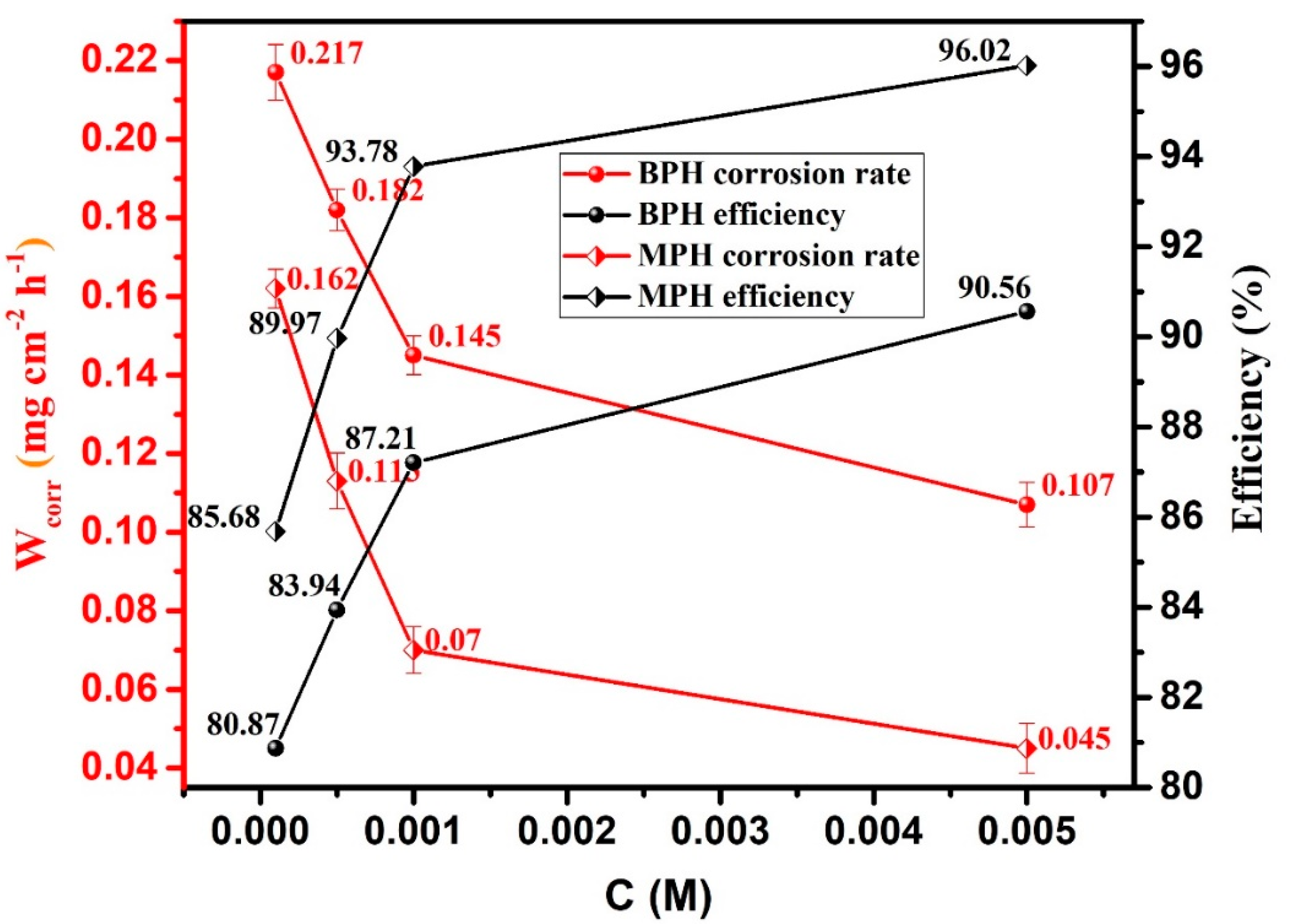

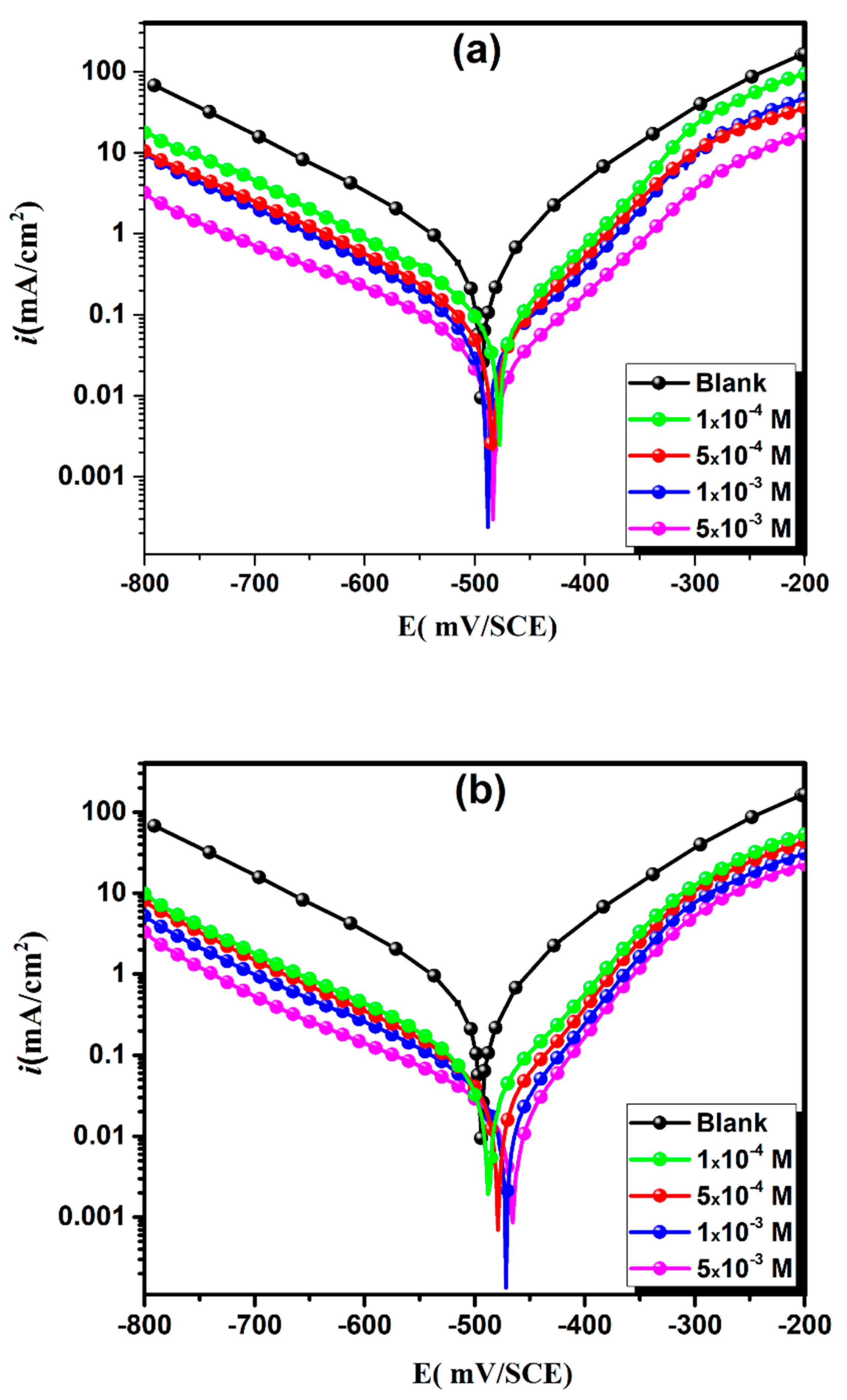
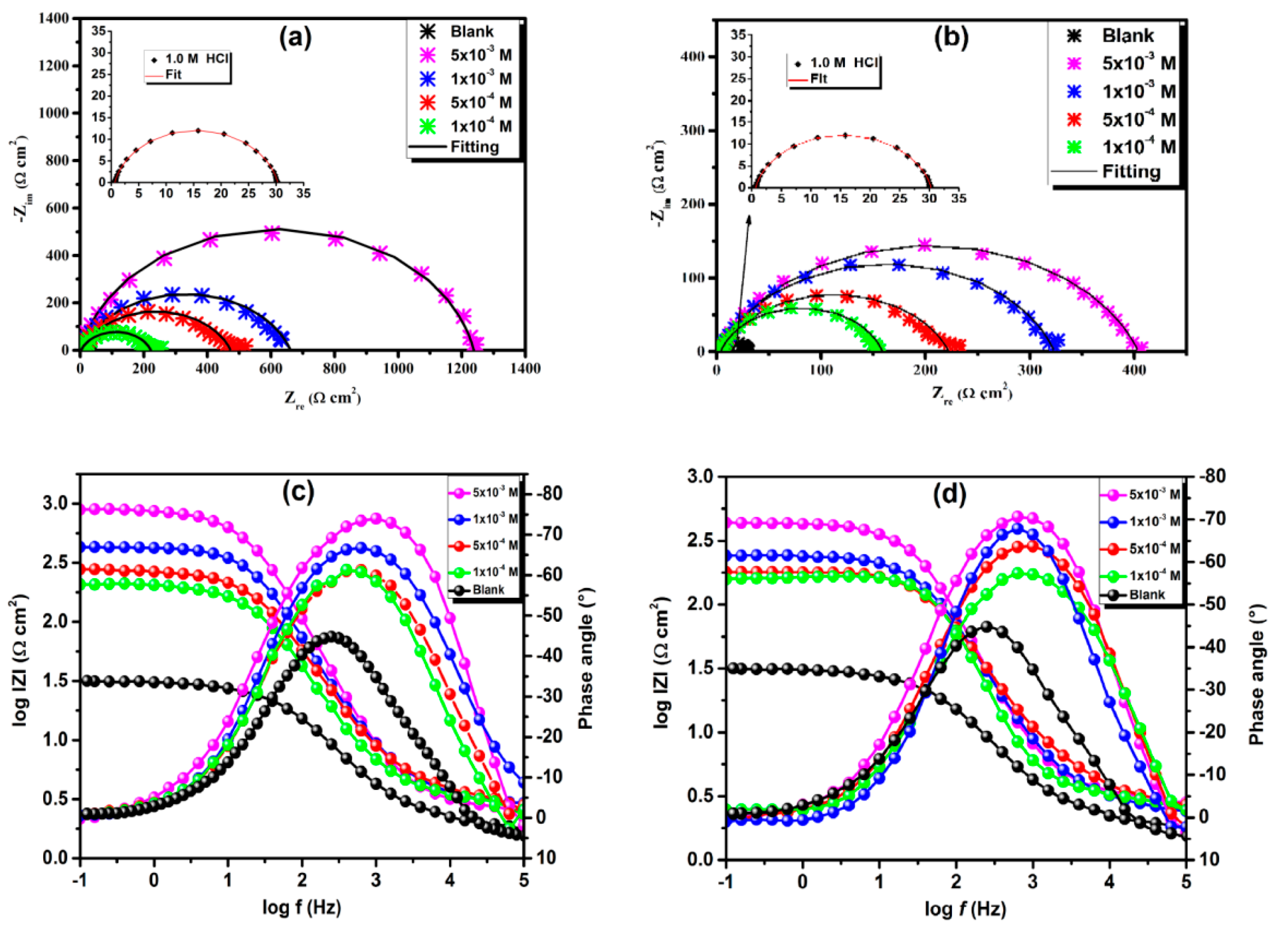
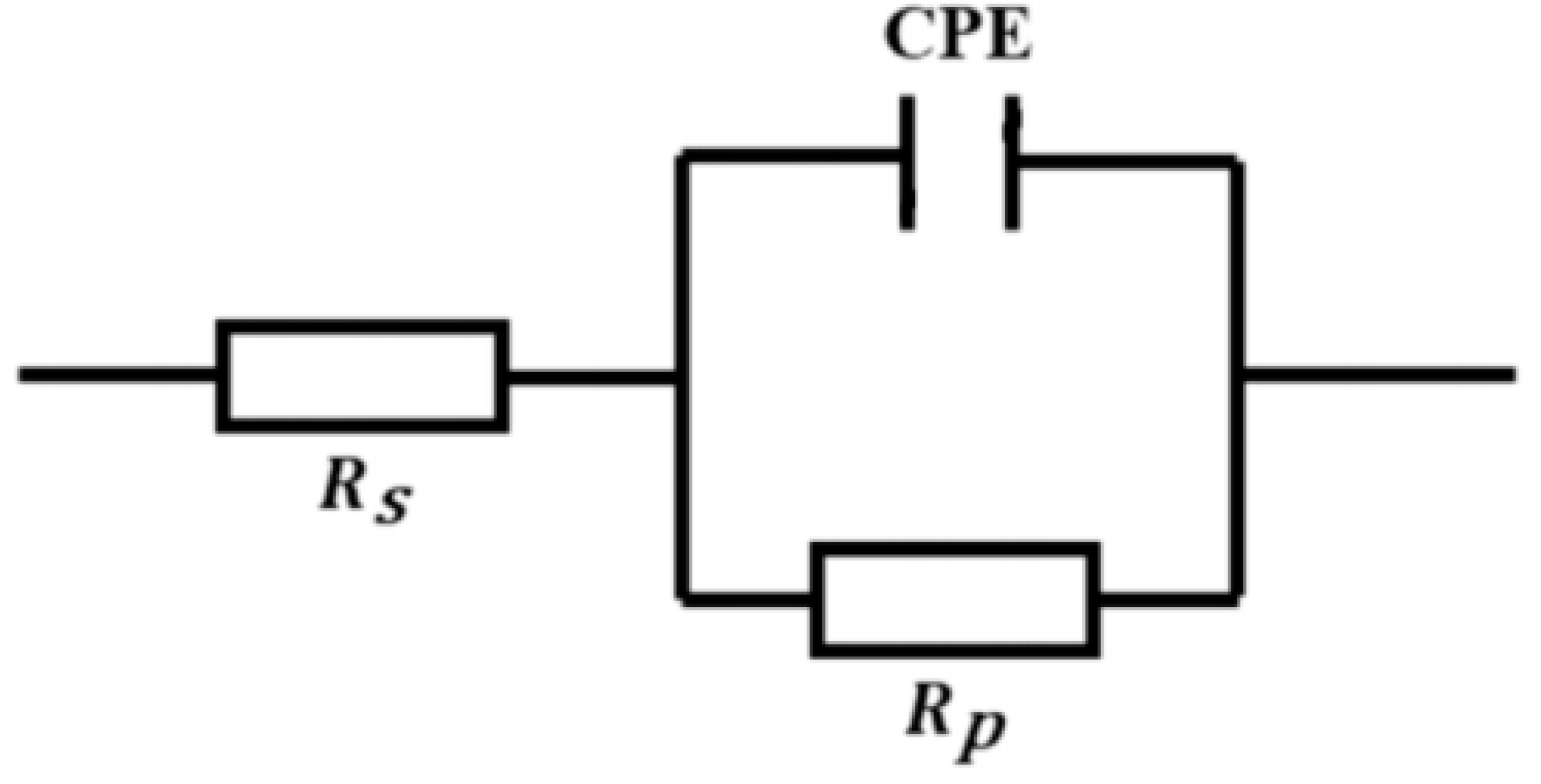
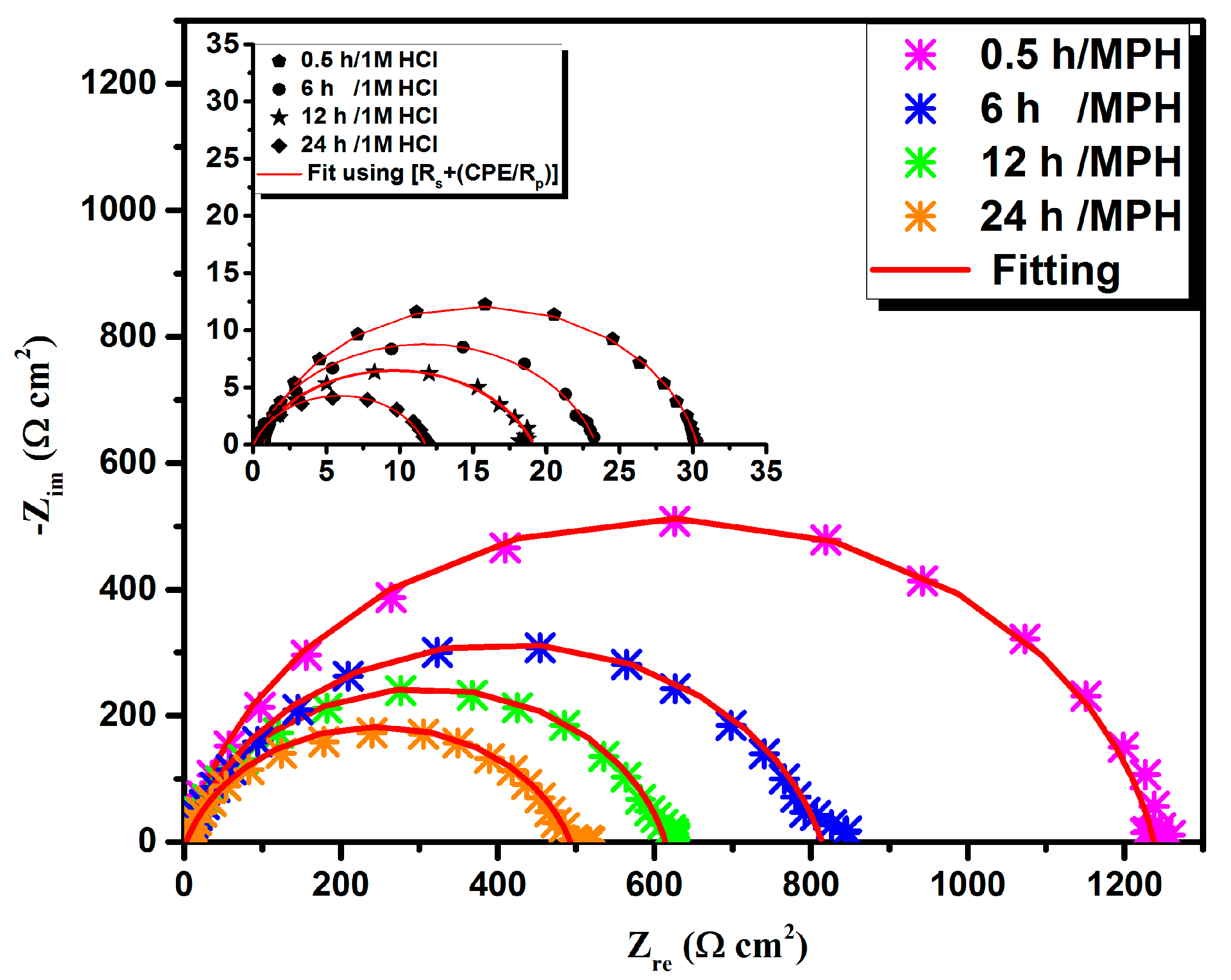
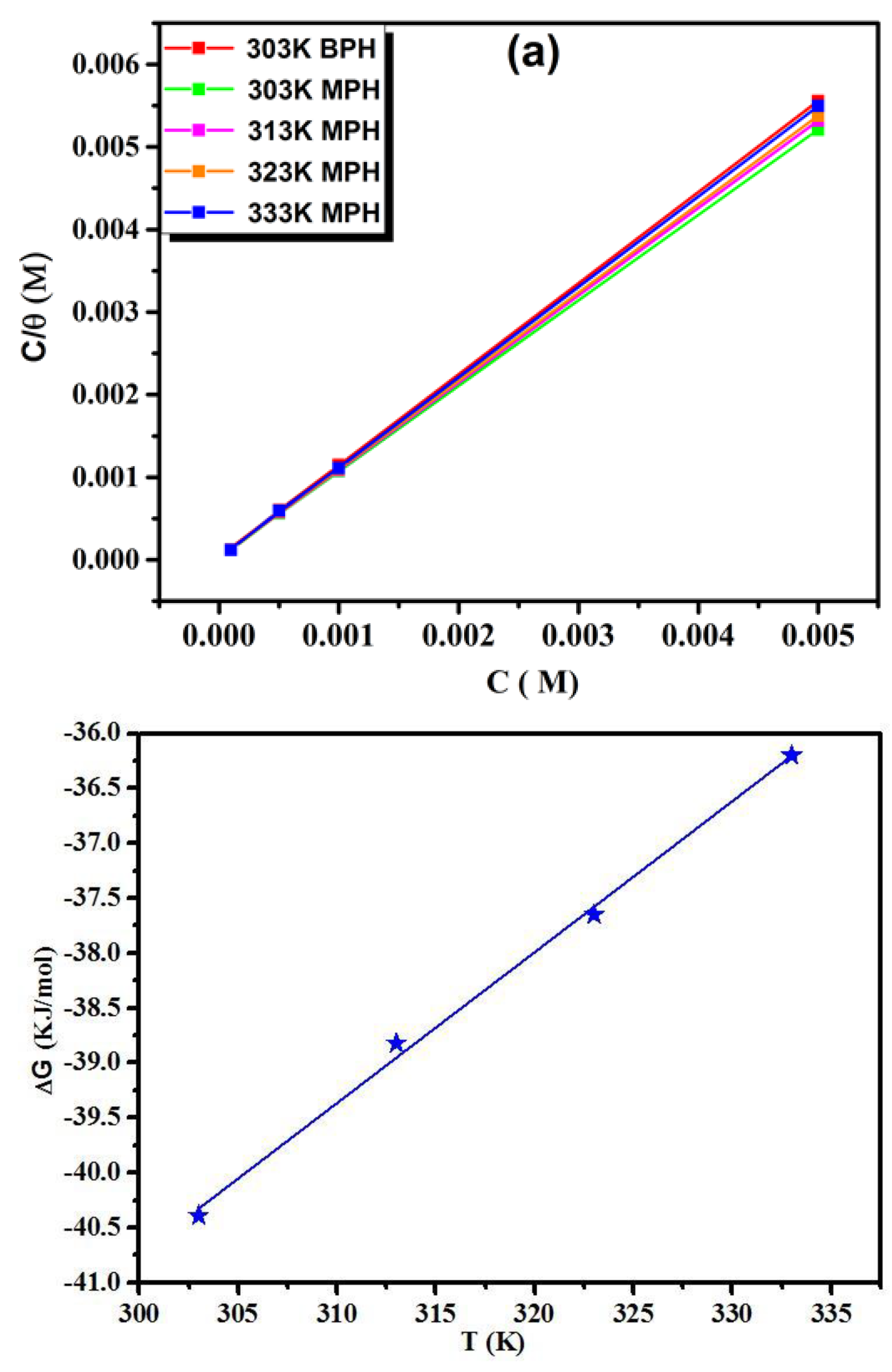
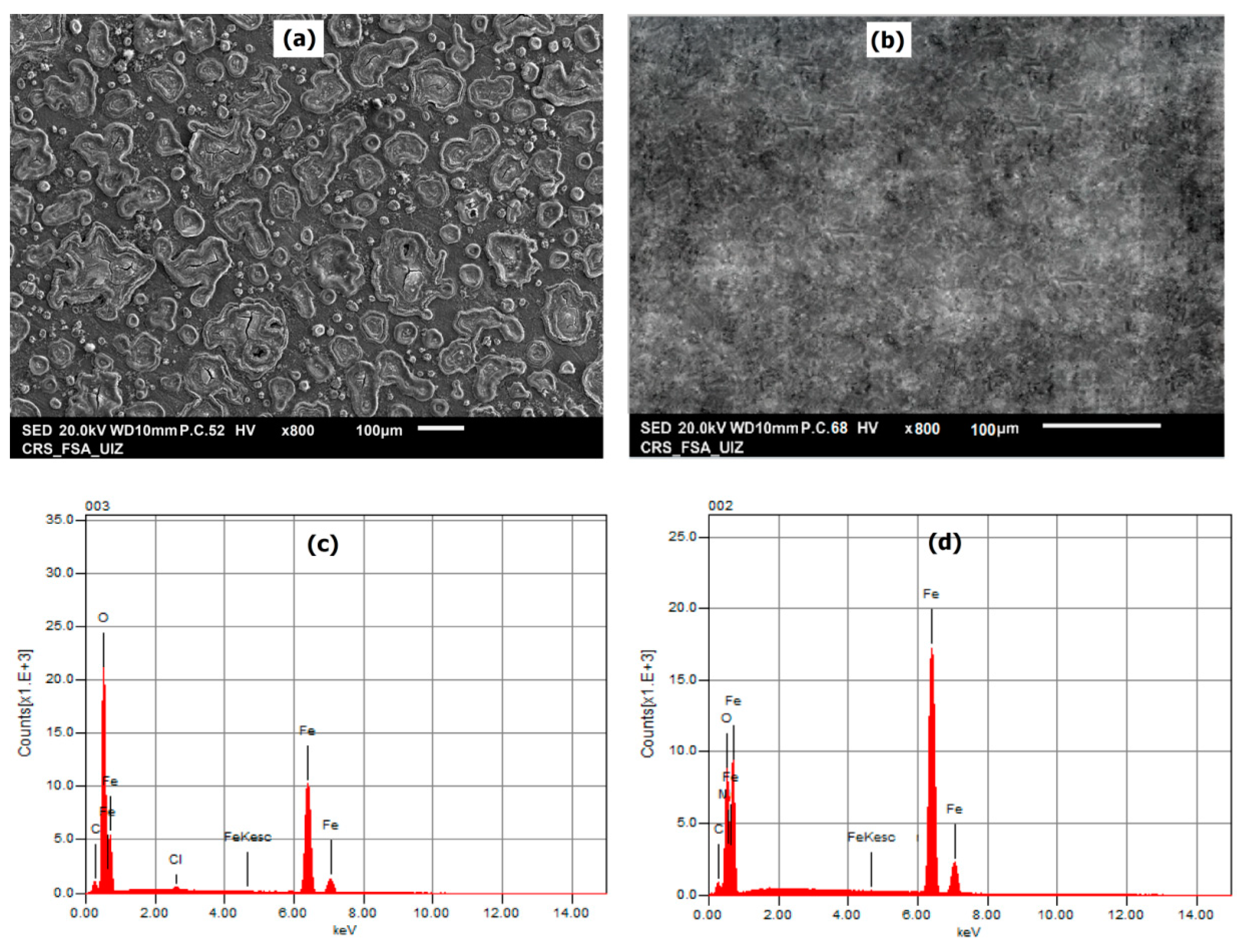
| Atom | Fe | C | Si | Mn | S | Cr | Ti | Ni | Co | Cu |
|---|---|---|---|---|---|---|---|---|---|---|
| Content (%) | 98.388 | 0.371 | 0.229 | 0.681 | 0.014 | 0.076 | 0.012 | 0.058 | 0.010 | 0.161 |
| Inhibitors | Names and Abbreviation |
|---|---|
 | (E)-N’-(4-bromobenzylidene)-2-(6-methoxynaphthalen-2-yl) propanehydrazide (BPH) |
 | (E)-N’-(4-(dimethylamino)benzylidene)-2-(6-methoxynaphthalen-2-yl) propanehydrazide (MPH) |
| Inhibitor | Concentration (mol/L) | (mg/(cm2 h)) | θ | ηW (%) |
|---|---|---|---|---|
| HCl | 1 | 1.135 ± 0.0121 | - | - |
| 1 × 10−4 | 0.162 ± 0.0049 | 0.85 | 85.68 | |
| 5 × 10−4 | 0.113 ± 0.0071 | 0.89 | 89.97 | |
| MPH | 1 × 10−3 | 0.070 ± 0.0059 | 0.93 | 93.78 |
| 5 × 10−3 | 0.045 ± 0.0062 | 0.96 | 96.02 | |
| BPH | 1 × 10−4 | 0.217 ± 0.0072 | 0.80 | 80.87 |
| 5 × 10−4 | 0.182 ± 0.0053 | 0.83 | 83.94 | |
| 1 × 10−3 | 0.145 ± 0.0041 | 0.87 | 87.21 | |
| 5 × 10−3 | 0.107 ± 0.0059 | 0.90 | 90.56 |
| Solution | Concentration | Temperature (K) | Corrosion Rate (mg/(cm2·h)) | Inhibition Efficiency (%) |
|---|---|---|---|---|
| Blank | 1.0 M HCl | 303 | 1.1350 ± 0.0121 | - |
| 313 | 1.4162 ± 0.0215 | - | ||
| 323 | 1.9981 ± 0.0214 | - | ||
| 333 | 2.5392 ± 0.0316 | - | ||
| MPH | 1 × 10−4 M | 303 | 0.162 ± 0.0049 | 85.68 |
| 313 | 0.219 ± 0.0077 | 84.50 | ||
| 323 | 0.319 ± 0.0079 | 84.01 | ||
| 333 | 0.420 ± 0.0011 | 83.44 | ||
| 5 × 10−4 M | 303 | 0.113 ± 0.0071 | 89.97 | |
| 313 | 0.178 ± 0.0055 | 87.42 | ||
| 323 | 0.277 ± 0.0079 | 86.11 | ||
| 333 | 0.386 ± 0.0038 | 84.78 | ||
| 1 × 10−3 M | 303 | 0.070 ± 0.0059 | 93.78 | |
| 313 | 0.110 ± 0.0049 | 92.21 | ||
| 323 | 0.176 ± 0.0081 | 91.19 | ||
| 333 | 0.244 ± 0.0090 | 90.36 | ||
| 5 × 10−3 M | 303 | 0.045 ± 0.0062 | 96.02 | |
| 313 | 0.082 ± 0.0059 | 94.14 | ||
| 323 | 0.138 ± 0.0021 | 93.08 | ||
| 333 | 0.214 ± 0.0064 | 91.55 |
| Parameters | Blank | MPH | |||
|---|---|---|---|---|---|
| 1 × 10−4 M | 5 × 10−4 M | 1 × 10−3 M | 5 × 10−3 M | ||
| Ea (kJ mol−1) | 23.12 | 27.12 | 34.66 | 35.41 | 43.66 |
| ΔHa (kJ mol−1) | 20.48 | 24.48 | 32.03 | 32.77 | 41.02 |
| ΔSa (J mol−1 K−1) | −176.48 | −167.07 | −157.27 | −158.83 | −135.14 |
| Ea −∆Ha (kJ mol−1) | 2.64 | 2.64 | 2.63 | 2.64 | 2.64 |
| Inhibitor | Concentration (M) | −Ecorr (mV vs. SCE) | −βc (mV dec−1) | icorr (mA cm−2) | CR (mm yr−1) | θ | (%) |
|---|---|---|---|---|---|---|---|
| Blank | 1.0 | 496.0 ± 0.4 | 162.0 ± 4.1 | 0.5640 ± 0.0023 | 6.64 | - | - |
| MPH | 1 × 10−4 | 488.8 ± 1.3 | 162.7 ± 4.4 | 0.0887 ± 0.0049 | 1.04 | 0.84 | 84.27 |
| 5 × 10−4 | 480.3 ± 0.2 | 168.7 ± 7.1 | 0.0617 ± 0.0059 | 0.73 | 0.89 | 89.06 | |
| 1 × 10−3 | 471.8 ± 0.9 | 169.2 ± 5.6 | 0.0424 ± 0.0056 | 0.50 | 0.92 | 92.48 | |
| 5 × 10−3 | 467.2 ± 0.8 | 180.3 ± 6.1 | 0.0261 ± 0.0018 | 0.31 | 0.95 | 95.37 | |
| BPH | 1 × 10−4 | 481.2 ± 0.7 | 138.1 ± 8.3 | 0.1115 ± 0.0046 | 1.31 | 0.80 | 80.23 |
| 5 × 10−4 | 484.3 ± 0.6 | 142.7 ± 1.2 | 0.0878 ± 0.0086 | 1.03 | 0.84 | 84.43 | |
| 1 × 10−3 | 489.8 ± 0.9 | 143.9 ± 7.6 | 0.0767 ± 0.0019 | 0.90 | 0.86 | 86.40 | |
| 5 × 10−3 | 484.9 ± 1.1 | 201.5 ± 6.7 | 0.0609 ± 0.0066 | 0.72 | 0.89 | 89.20 |
| Inhibitor | Concentration (M) | −Ecorr (mV vs. SCE) | −βc (mV dec−1) | icorr (mA cm−2) | θ | (%) |
|---|---|---|---|---|---|---|
| Blank | 1.0 | 496.0 ± 0.4 | 162.0 ± 4.1 | 0.5640 ± 0.0023 | - | - |
| MPH | 1 × 10−4 | 488.8 ± 1.3 | 162.7 ± 4.4 | 0.0887 ± 0.0049 | 0.84 | 84.27 |
| 5 × 10−4 | 480.3 ± 0.2 | 168.7 ± 7.1 | 0.0617 ± 0.0059 | 0.89 | 89.06 | |
| 1 × 10−3 | 471.8 ± 0.9 | 169.2 ± 5.6 | 0.0424 ± 0.0056 | 0.92 | 92.48 | |
| 5 × 10−3 | 467.2 ± 0.8 | 180.3 ± 6.1 | 0.0261 ± 0.0018 | 0.95 | 95.37 | |
| BPH | 1 × 10−4 | 481.2 ± 0.7 | 138.1 ± 8.3 | 0.1115 ± 0.0046 | 0.80 | 80.23 |
| 5 × 10−4 | 484.3 ± 0.6 | 142.7 ± 1.2 | 0.0878 ± 0.0086 | 0.84 | 84.43 | |
| 1 × 10−3 | 489.8 ± 0.9 | 143.9 ± 7.6 | 0.0767 ± 0.0019 | 0.86 | 86.40 | |
| 5 × 10−3 | 484.9 ± 1.1 | 201.5 ± 6.7 | 0.0609 ± 0.0066 | 0.89 | 89.20 |
| Inhibitor | Time | θ | (%) | ||||
|---|---|---|---|---|---|---|---|
| Blank | 0.5 | 29 ± 1.5 | 0.89 ± 0.005 | 1.7610 ± 0.0025 | 92 | - | - |
| 6 | 23 ± 2.5 | 0.84 ± 0.007 | 2.5114 ± 0.0037 | 94 | - | - | |
| 12 | 18 ± 1.7 | 0.83 ± 0.004 | 2.9866 ± 0.0084 | 102 | - | - | |
| 24 | 12 ± 2.9 | 0.88 ± 0.003 | 3.0891 ± 0.0031 | 144 | - | - | |
| MPH | 0.5 | 1235 ± 1.7 | 0.83 ± 0.009 | 0.1472 ± 0.0043 | 6.47 | 0.97 | 97.62 |
| 6 | 811.3 ± 1.9 | 0.82 ± 0.003 | 0.2257 ± 0.0022 | 9.33 | 0.97 | 97.16 | |
| 12 | 610.9 ± 2.0 | 0.80 ± 0.011 | 0.3493 ± 0.0059 | 13.35 | 0.97 | 97.05 | |
| 24 | 490.0 ± 1.7 | 0.78 ± 0.013 | 0.6433 ± 0.0091 | 24.26 | 0.97 | 97.55 |
| Inhibitor | Temperature (K) | Kads (L mol−1) | R2 | ∆G°ads (kJ mol−1) | ΔHa (kJ mol−1) | ΔSa (J mol−1 K−1) |
|---|---|---|---|---|---|---|
| BPH | 303 | 28,142 | 0.999 | −35.90 | - | - |
| MPH | 303 | 31,588 | 0.999 | −40.39 | −81.95 | −13.7 |
| 313 | 34,901 | 0.999 | −38.82 | |||
| 323 | 34,486 | 0.999 | −37.65 | |||
| 333 | 39,347 | 0.999 | −36.20 |
© 2020 by the authors. Licensee MDPI, Basel, Switzerland. This article is an open access article distributed under the terms and conditions of the Creative Commons Attribution (CC BY) license (http://creativecommons.org/licenses/by/4.0/).
Share and Cite
Chafiq, M.; Chaouiki, A.; Al-Hadeethi, M.R.; Ali, I.H.; Mohamed, S.K.; Toumiat, K.; Salghi, R. Naproxen-Based Hydrazones as Effective Corrosion Inhibitors for Mild Steel in 1.0 M HCl. Coatings 2020, 10, 700. https://doi.org/10.3390/coatings10070700
Chafiq M, Chaouiki A, Al-Hadeethi MR, Ali IH, Mohamed SK, Toumiat K, Salghi R. Naproxen-Based Hydrazones as Effective Corrosion Inhibitors for Mild Steel in 1.0 M HCl. Coatings. 2020; 10(7):700. https://doi.org/10.3390/coatings10070700
Chicago/Turabian StyleChafiq, Maryam, Abdelkarim Chaouiki, Mustafa R. Al-Hadeethi, Ismat H. Ali, Shaaban K. Mohamed, Karima Toumiat, and Rachid Salghi. 2020. "Naproxen-Based Hydrazones as Effective Corrosion Inhibitors for Mild Steel in 1.0 M HCl" Coatings 10, no. 7: 700. https://doi.org/10.3390/coatings10070700
APA StyleChafiq, M., Chaouiki, A., Al-Hadeethi, M. R., Ali, I. H., Mohamed, S. K., Toumiat, K., & Salghi, R. (2020). Naproxen-Based Hydrazones as Effective Corrosion Inhibitors for Mild Steel in 1.0 M HCl. Coatings, 10(7), 700. https://doi.org/10.3390/coatings10070700






